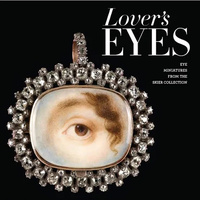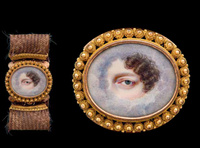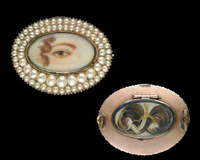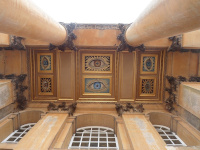Lover’s Eyes: Eye Miniatures from the Skier Collection edited by Elle Shushan
Reviewed by Anne WallentineAnne Wallentine
Writer and art historian
Email the author: Akwallentine[at]gmail.com
Citation: Anne Wallentine, book review of Lover’s Eyes: Eye Miniatures from the Skier Collection edited by Elle Shushan, Nineteenth-Century Art Worldwide 21, no. 1 (Spring 2022), https://doi.org/10.29411/ncaw.2022.21.1.13.
This work is licensed under a Creative Commons Attribution-NonCommercial 4.0 International License  unless otherwise noted.
unless otherwise noted.
Your browser will either open the file, download it to a folder, or display a dialog with options.

Elle Shushan, ed.,
Lover’s Eyes: Eye Miniatures from the Skier Collection.
Lewes, UK: D. Giles Limited, 2021.
280 pp.; 304 color illus.; catalogue; bibliography; index.
$57 (hardcover)
ISBN: 978–1–911282–93–8
The story of eye miniatures always seems to begin with the love affair between the Prince of Wales—the future King George IV—and the Catholic Maria Fitzherbert. Parliament had banned members of the Royal family from marrying Catholics in the Royal Marriages Act of 1772. Undeterred, the couple not only married in 1785 but commemorated their secret courtship with an exchange of miniatures that featured their eyes, as intimate and purportedly anonymous tokens. While the ostensibly secret nature of the objects was never much of a guarantee, their intimacy inspired a popular trend in England that lasted through the 1820s, when the tokens fell out of fashion almost as suddenly as they arrived.
However, origin stories are rarely so neat. Like so many things claimed as English, the eye miniature trend actually began elsewhere—in this case, France. As Horace Walpole wrote in a 1785 letter: “Lord, don’t you know it? A Frenchman is come over to paint eyes here” (16). While the glamorous royal narrative is detailed in Lover’s Eyes: Eye Miniatures from the Skier Collection, edited by Elle Shushan, the book’s essays also effectively situate eye miniatures within this broader tradition of eye and portrait miniatures, their symbolism, and the currents of artistic influence. The catalogue’s rigorous research both clarifies and contextualizes the importance of eye miniatures and makes intriguing additions to the scholarship about their impact and afterlife.
Lover’s Eyes catalogues the private collection of Nan and Dr. David Skier—who is, appropriately enough, an eye surgeon—which has become one of the most extensive collections in existence and demonstrates the variety of settings and uses of the form. Most frequently painted in watercolor on ivory, eye miniatures could be set in bracelets, brooches, pendants, rings, boxes, or even a rare wallet (figs. 1, 2). While the so-called “lover’s eyes” of the title certainly comprised a large portion of eye miniatures, the objects were created and given to commemorate familial and close relationships as well as romantic ones. Queen Victoria often commissioned eye miniatures of her children and friends as gifts or presentation pieces.


Shushan and Graham C. Boettcher further explain eye miniatures’ variety with essays on the symbolic languages of jewels and flowers, which flourished in the Georgian and Victorian periods and added to the layers of meaning contained in the era’s sentimental jewellery. Eye miniatures set in pearls, for example, could represent tears, indicating a personal function as a memorial. Hairwork was also inset, especially in the Victorian period, as a way of preserving another physical element of a lost loved one (fig. 3). When flowers were painted around the eye, laburnum could add to the symbolism of mourning, while ivy promised fidelity and longevity. Many eye miniatures have been detached from their origins and identities through lack of documentation, and now appear mysterious in their anonymity. But a close reading of the symbols and settings of the objects, as well as the paintings themselves, allows scholars to tease out their importance—even if individual names and stories remain lost.


Though Queen Victoria continued to commission them, eye miniatures had fallen out of fashion by the 1840s, witheringly described in Charles Dickens’ Dombey and Son (1848) as a shorthand for old-fashioned tastes. The advent of photography contributed to their demise, as photorealistic likenesses could now be captured and shared more broadly (and eventually, more cheaply) as well. Shushan notes that some artists continued to paint generic eyes rather than portraits for use as jewelry, complicating our understanding of the objects’ meaning and use over time—rather than highly personal and specific tokens, they became, for some people, mere fashion.
The most interesting new scholarship is found in Boettcher’s essay “Love Never Dies,” which moves beyond the well-known story of eye miniatures’ history in France and England into their afterlife and impact in the later nineteenth and twentieth centuries. Not only did newspapers report a brief fad for the form in America at the turn of the twentieth century, but large, surveilling eye portraits became part of the interior decoration of several grand English homes. The larger-than-life-size eye of Mary Augusta Fox, Lady Holland, was set into a mantelpiece in her Kensington home. It was documented in an 1889 engraving and later destroyed by bombing in World War II. She and her husband joked about it in letters, its installation raising interesting questions of surveillance, possession, and how the gaze can be used to mark territory: a near-literal interpretation of “keeping an eye on” things. Similarly, the Duchess of Marlborough commissioned a muralist to paint the oversize blue and brown eyes of herself and her husband on the ceiling of Blenheim Palace in 1928 (fig. 4). No longer an intimate, private gesture, the vacant gaze of their eyes becomes uncanny and perhaps Orwellian. By the 1930s, Surrealists René Magritte and Salvador Dalí were also experimenting with the meanings of eyes, from a small-scale eye portrait by Magritte to Dali’s Eye of Time (1949), a jeweled brooch and functioning watch in the shape of an eye that he created for his wife. It would be fascinating to see more work done on the varied ways eye portraits were incorporated in domestic and public settings, and how quickly their import could change based on size and surrounding.
Boettcher also traces the fluctuations of eye miniatures’ popularity through the present day, including contemporary approaches that reference and play with the conventions of the form. These include eye miniatures of famous portraits in art history like the Mona Lisa (1503), animal eye miniatures that commemorate attachments to pets, and depictions of other fragments of the body. Contemporary artist Fatima Ronquillo combines the visual traditions of eye miniatures and Mexican milagros, or devotional charms; her work, which includes depictions of people of color, throws into stark contrast the homogeneous whiteness of the nineteenth century objects. Though brief, this survey of eye miniatures’ afterlife provides a compelling understanding of how they have functioned as both art and fashion, and how they continue to do so.
Lover’s Eyes builds on a previous catalogue of the same collection from 2012, which included imaginative fiction—short vignettes by Jo Manning—as well as factual research.[1] While it included contextual essays on jewellery and hairwork, it leaned more heavily on the objects’ romance. This publication is distinguished by taking a more rigorous than fanciful approach to the subject than its predecessor, which the objects deserve. The longer, more in-depth essays and detailed archival research push beyond the romantic narrative to create a building block for further scholarship. The outstanding work on eye miniatures remains Hanneke Grootenboer’s Treasuring the Gaze, with her insightful analysis of reciprocal vision in intimate objects that related the painted gaze to the physical and philosophical world of the late eighteenth and nineteenth centuries.[2] While Lover’s Eyes remains more catalogue than argument, it provides a highly useful, foundational resource by detailing the material culture, settings, and uses of eye miniatures in what is likely the most extensive collection outside of a museum. Because of this, Lover’s Eyes lays the groundwork for further research into eye miniatures, sight, and intimacy across disciplinary boundaries. Eye miniatures’ multiplicity of meanings and connections to other art forms demonstrate that intimate objects matter, in ways that can be both recognizable and mysterious, individual and universal. The important thing is to keep looking.